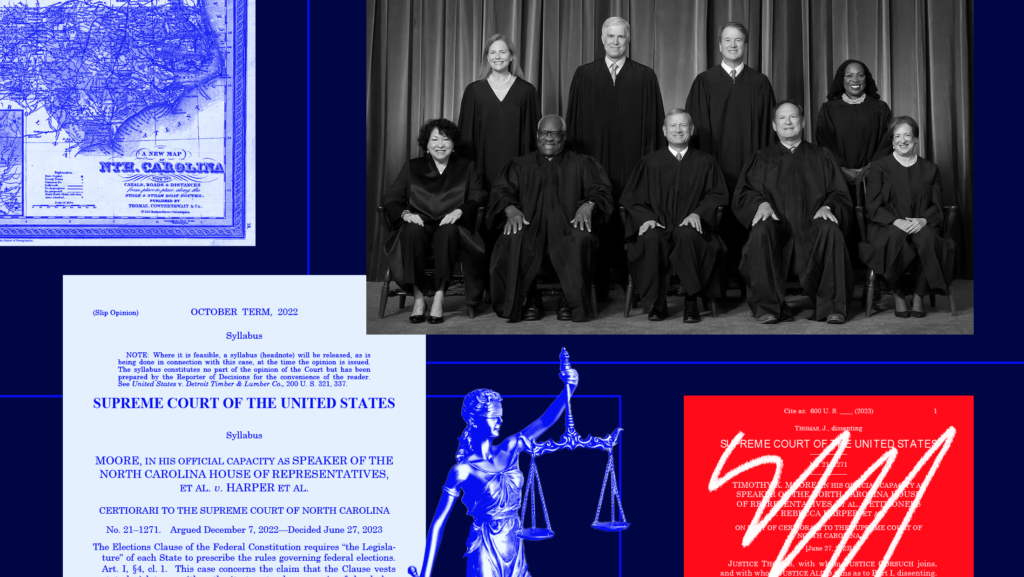A Dangerous Legal Theory Is Rejected

“The Elections Clause does not insulate state legislatures from the ordinary exercise of state judicial review.”
With those words, Chief Justice John Roberts put an end to the right-wing legal fantasy that state legislatures are free to enact laws governing federal elections without regard to their state constitutions and review by their state courts. Writing for a six-justice majority, the Chief firmly rejected the so-called independent state legislature (ISL) theory. Anyone who cares about free and fair elections should rejoice.
The case, Moore v. Harper, involved a partisan gerrymandering challenge to North Carolina’s congressional map. Citing the North Carolina Constitution in early 2022, the state Supreme Court struck down the GOP-sponsored map. Republican state lawmakers sought review by the U.S Supreme Court.
The crux of their argument was language in the U.S. Constitution that grants state legislatures the ability to set the “time, place and manner” of congressional elections, subject only to an override by Congress. Since state courts are neither the state legislature nor Congress, the reasoning goes, they remain powerless to review and strike down legislative enactments, including redistricting lines, that involve federal elections.
In the run up to the November 2020 presidential election, Republicans unsuccessfully tried to use this theory to overturn pro-voting state court rulings in Pennsylvania and North Carolina that played a vital role in protecting the right to vote in free and fair elections.
In Moore, the ISL theory did not just fail to gain a majority, it emerged discredited.
After the 2020 election, lawyers for former President Donald Trump argued that a similar provision that grants legislatures the authority to determine the “manner” of choosing presidential electors supported their theory that state legislatures could retroactively overturn election results. Texas asked the U.S. Supreme Court to invalidate the presidential election results in Georgia, Michigan, Pennsylvania and Wisconsin. John Eastman advanced an extreme form of the theory in advising states to disregard the election results altogether.
Very little about this argument ever made sense. After all, a bedrock principle of federalism — a tenet of modern conservative legal theory — is that state courts are the ultimate authority on interpreting and applying their state’s laws and constitutions. In addition, stripping or limiting judicial review runs counter to the Supreme Court’s own jurisprudence since Marbury v. Madison.
Yet, as conservatives embraced the MAGA movement, the ability to restrict voting and overturn free and fair elections trumped (literally and figuratively) all other considerations. Cynically, many Republicans assumed that a conservative majority on the Court would reflexively accept this novel theory and make it an accepted doctrine of law. Not only did six justices refuse the invitation, but a seventh — Justice Samuel Alito — voted simply to dismiss the case on jurisdictional lines. Only Justices Clarence Thomas and Neil Gorsuch expressed support for this radical theory.
The results of Moore are strikingly similar to those delivered by the 5-4 majority a week earlier in Allen v. Milligan. In that case, the Supreme Court reaffirmed its longstanding application of Section 2 of the Voting Rights Act. Since then, maps in other Republican-controlled states have been identified as in serious danger.
In Moore, the ISL theory did not just fail to gain a majority, it emerged discredited. The result will be to remove a cloud over the 28 active state court cases that challenge congressional maps and state laws regulating federal elections. Most immediately impacted will be the seven cases that involve state constitutional challenges to congressional maps, almost all of which bring partisan gerrymandering claims. In the longer term, the remaining 21 lawsuits aimed at voter suppression and election subversion laws will continue unimpeded by the threat of the ISL theory.
In the aftermath of Moore and Allen, with the specter of a hostile Supreme Court removed, we can expect to see even more litigation aimed at protecting free and fair elections. In that sense, democracy did not just dodge two bullets, it emerged stronger as a result.
At his judicial confirmation hearing, Roberts likened the role of a Supreme Court justice to that of a baseball umpire. “I will decide every case based on the record,” he assured the Senate in 2005. “And I will remember that it’s my job to call balls and strikes and not pitch or bat.” Contrary to many predictions, in Moore, Roberts and a majority of his colleagues made good on that promise.
Importantly, the Court also ensured that state judges will be able to act as umpires as well. Making sure that those who pitch, catch, hit and run in elections all play by the rules. And, that no one can try to steal a base without someone ready to call them out.